
As Republican candidate Donald Trump was declared the Victor During the US presidential election, a clip of the president-elect allegedly threatening Canadian Prime Minister Justin Trudeau went viral on TikTok (archived previews here, here, And here).
The clip is believed to be a recording of Trump’s speech in which he says: “Mr. Trudeau… if he is re-elected in Canada, I will personally have him arrested if he so much as sets foot in the United States, and I will possible. Canada a favor and throw away the key. I will end Canada’s dictatorship once and for all. Stay strong, Canada, our neighbors, our brothers. God bless you all. Thank you.”
However, Logically Facts found no record of Donald Trump making such a statement. According to experts, there is a good chance that the audio was created with artificial intelligence.
High chance of AI-generated audio
We contacted two experts to verify the authenticity of the audio. Both tested the audio clip with AI detection tools and found that it was likely fake.
Professor at the UC Berkeley School of Information, Hany Faridtold Logically Facts: “I analyzed this audio with a model trained to distinguish real voices from AI-generated voices. The model confidently marks this recording as AI-generated.”
Nicholas Müllera machine learning researcher at the Fraunhofer Institute for Applied and Integrated Security, tested the same audio on their platform Deepfake Total. “The AI system predicts that the audio is fake,” Müller told Logically Facts.
This tool gave the Trump audio a “deepfake score” of 99.9 percent. The result “indicates that the soundtrack in the video has a 99.9 percent probability of being a deepfake.”
 Screenshot of the Deepfake Total audio analysis results indicating the audio is fake. (Source: Fraunhofer AISEC)
Screenshot of the Deepfake Total audio analysis results indicating the audio is fake. (Source: Fraunhofer AISEC)
Deepfake detection models can strongly indicate whether an audio is authentic, but their results cannot be considered definitive proof.
However, other clues suggest the audio isn’t real. “Additionally, the voice shows signs of being AI-generated in terms of cadence and intonation,” Farid told Logically Facts.
What else have we found?
A Google search didn’t lead us to any results where Trump made such a statement. The latest reports about Trump and Trudeau refer to that of the Canadian Prime Minister congratulatory message to Trump in his re-election. They report no threats from Trump to Trudeau.
In the TikTok clips, the audio is accompanied by two side-by-side images of Trump and Trudeau, or a photo of them standing next to each other. A reverse image search revealed that the photos are not recent or related to the election. The image of Trudeau could be, for example found until 2021, and the image of the two together was captured in 2017 during Trudeau’s visit to the White House.
The difficulty of verifying AI audio
Checking whether an audio clip is real or fake has become more and more common complex as technology rapidly advances and AI voices become more convincing. Audio recordings provide less context to check, such as visual cues shared in AI images and videos.
“Determining why audio is classified as fake or real can be complex,” Müller told Logically Facts. “Real audio often includes natural prosody and liveliness that matches the spoken content, but with advances in TTS (Text-to-Speech) technology, it is challenging to identify a single characteristic that distinguishes authentic audio from synthetic.”
I’ve spoken to Logical Facts beforeOli Buckley, now professor of cyber security at Loughborough University, suggested paying attention to the text-to-speech language used and asking a few simple questions to determine whether the audio is real or fake.
“It’s things like being objective, would the person say that? If it’s from the nature of the story, how likely is it that they said it? Listen to the rhythm and cadence of the words: is this the way the person normally talks?”
Logically, Facts has contacted Donald Trump’s office, but has not yet received a response.
This report first appeared on logicalfacts.comand has been republished on ABP Live as part of a special package. Other than the headline, no changes have been made to the ABP Live report.
Leave a Reply